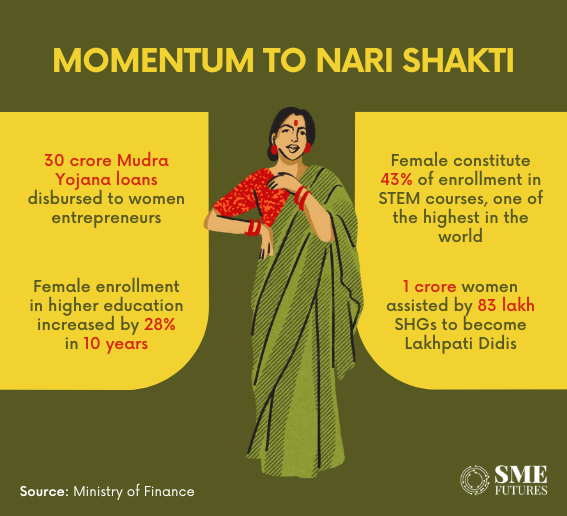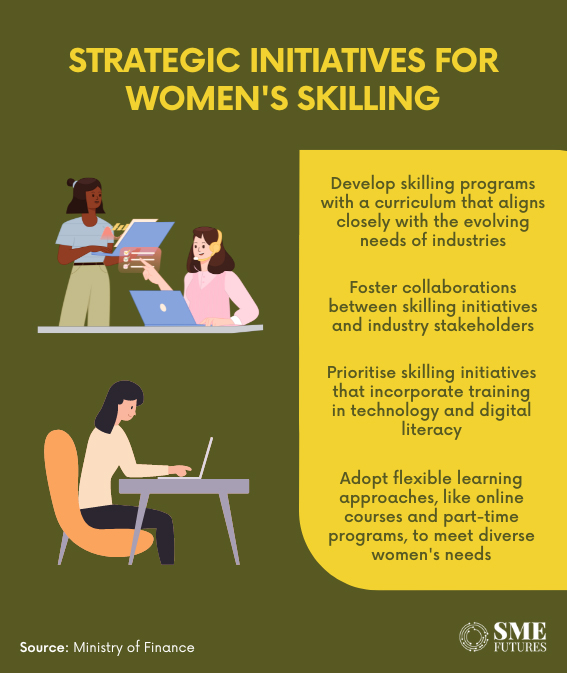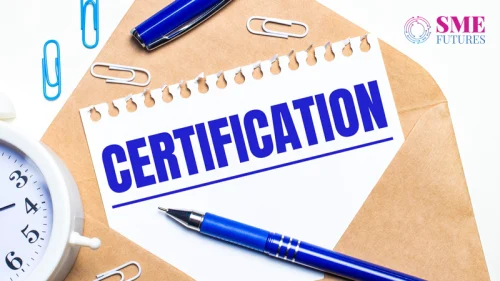In a groundbreaking shift, India’s G20 presidency has ushered in a new era of economic policies, steering away from viewing women merely as beneficiaries to recognising them as drivers of growth and development. Finance Minister Nirmala Sitharaman’s recent announcements in the Interim Budget 2024 have set the stage for a transformative journey towards women-led development. Delving into the multifaceted landscape of women’s empowerment and further examining the expansion of schemes, strides in education and healthcare initiatives, the decisions taken give us an outlook on the evolving opportunities for women in rural India.
Building a comprehensive care economy

To empower women, addressing the burdens on both the supply and demand sides is imperative. Initiatives, such as the Ujjwala Yojana, focused on reducing the time women spend on household chores, underscore the government’s commitment. This further emphasises the importance of enhancing budgetary allocations for existing schemes and expanding infrastructure for creches and day-care centres. “Financial inclusion is critical for the economic empowerment of women in India. The interim budget highlights the importance of women-centric policies and allocations for fostering economic growth in the country,” says Shruti Swaroop, Founder, Embrace Consulting.
“We are happy to see the progressive stance on women empowerment that the government has shown over the past decade. The disbursement of Rs 30 crores in loans as part of Mudra Yojana to women entrepreneurs aligns seamlessly with the broader vision of fostering economic independence and supporting the entrepreneurial streak in women,” says Arpita Katyal, CEO, Reperro.
Sectoral approach to boosting women’s employment

The substantial surge in female labour force participation or LFPR in rural areas from 24.6 per cent in 2017-18 to 41.5 per cent in 2022-23, has notable implications for self-employment and agricultural trends. “This positive trend is in harmony with the rural development objectives outlined in the budget, showcasing favourable results arising from heightened household earnings, improved education levels among women, and enhanced access to essential amenities,” says Swaroop.
Identifying sectors with a high concentration of female workers has emerged as a key focus. The Production Linked Incentive (PLI) scheme served as a model, with targeted incentives proposed for sectors like textiles, garments, food processing, tourism, and caregiving. The goal is to accelerate the growth of these women-employment-intensive industries, creating a ripple effect on economic empowerment.
“In her address, the finance minister highlighted the achievements of the past decade, emphasising the government’s commitment to inclusive growth, particularly targeting Gharib, Youth, Annadata and Nari,” underlines Anooshka Bathwal, CEO & Founder, Dhanvesttor.
Bridging the digital gender gap
While India’s digital transformation has opened new avenues for economic empowerment, a digital gender gap persists. There is a need for increased budgetary allocations for digital skilling, ensuring that women are equipped with essential digital acumen. Bridging this gap is crucial not only for access but also for empowering women to enter new-age, high-growth sectors, particularly in STEM (Science, Technology, Engineering, and Mathematics) fields.
“By placing ‘Mahila’ at the forefront of its agenda, the budget opens numerous opportunities for women, especially in rural regions,” says Shaifalika Panda, Trustee & Founder CEO, Bansidhar & Ila Panda Foundation (BIPF); Chief of CSR (Special Initiatives), Indian Metals and Ferro Alloys (IMFA).
Women-led urban development scheme
Access to safe and reliable urban transport services has emerged as a facilitator for women’s economic participation. The proposed ‘Women-led Urban Development Scheme’ seeks to enhance urban transport infrastructure and address gender-specific needs. It envisions a coordinated approach, encompassing data analysis, safety measures, employment opportunities, care infrastructure, and transformative urban governance to mainstream gender equality.
“The interim budget takes significant strides in women empowerment. Programmes like Lakhpati Didi, which aim to empower women through self-help groups (SHGs), and the expansion of Ayushman Bharat healthcare coverage to ASHA workers, Anganwadi workers and helpers demonstrate a dedication to enhancing the economic and health opportunities for women,” says Nidhi Mehra, Co-Founder, MyPlan8.
While India has embraced gender budgeting since 2005-06, the importance of moving towards an outcome-based gender budget needs to be highlighted. Shifting the focus from inputs to outcomes could significantly contribute to advancing women-led development. This underscores the need for a nuanced approach that goes beyond allocating funds to assess the impact and outcomes of these allocations.
“The facilitation of a Rs 34 crore loan for women entrepreneurs, along with the 43% female enrolment in STEM courses and the allocation of 1/3 seats in government, reflect a commitment to equal representation,” says Pallavi Singh Marwah, Senior VP, SPPL.
As per the 2023 Global Gender Gap Index report, India ranks 127th among 146 countries worldwide. “We need targeted interventions to empower women economically. India faces a significant gender pay gap, with men earning 82% of the labour income compared to women earning only 18%,” Singh adds.
“The COVID-19 pandemic has reversed decades of progress, as evidenced by a 7% increase in the gender pay gap between 2018-19 and 2020-21. The government can implement targeted policies and interventions to mitigate the impact of the pandemic on women’s economic empowerment. This may include financial support, skill development programmes, and job creation initiatives,” she asserts.
Industry speak: Amplifying the narrative
Most industry leaders echo the sentiments of progress and commitment towards women’s empowerment. Arpita Katyal emphasises that the increase in female enrolment in higher education, especially in STEM courses, reflects a positive shift towards gender inclusivity.
Anooshka Bathwal lauds the government’s progress under the PM Awas Yojana which highlights it commitment to inclusive growth. The increase in infrastructure spending and the focus on railway infrastructure indicate opportunities for societal progress.
Shaifalika Panda underscores the importance of Self-Help Groups (SHGs) in rural regions, calling them a guiding force for women-led development. The Mudra Yojana loans will play a crucial role in fuelling the entrepreneurial dreams of women, especially in rural areas.
“The focus on housing schemes and rooftop solarisation directly impacts the well-being of women and children,” Panda contends.
Shaina Ganapathy, Head of Community Outreach, Embassy Group draws connections between skilling and credit initiatives under DAY-NRLM and MGNREGA, emphasising their role in economic resurgence. The surge in female labour force participation in rural areas is seen as a catalyst for India’s social, economic, and environmental transformation.
Muskan Kakkar, COO and CO-founder of GoMechanic says, “The credit opportunities offered through DAY-NRLM empower entrepreneurs to invest in activities that generate income, thereby contributing to the ongoing economic revival. The amalgamation of skill development and credit programmes within DAY-NRLM, along with the employment-focused strategy of MGNREGS, collaboratively plays a role in uplifting rural communities, fostering economic growth, and aligning with the FM’s vision for a robust and rejuvenated economy.”
Conclusion

As India embraces women-led development, the Interim Budget of 2024 marks a crucial step towards uplifting women. Industry insights further underscore the importance of a holistic approach, addressing constraints on both the supply and demand sides. The government’s commitment to building a comprehensive care economy, boosting women’s employment, digital skilling, urban development, and moving towards an outcome-based gender budget reflects a forward-looking strategy.
With industry leaders applauding these measures, the path is set for a brighter and more inclusive future for women in India. The narrative of women-led development is evolving, and as the budget’s vision unfolds, it becomes clear that empowering women is not just a goal but a transformative journey towards a more equitable and prosperous nation.











